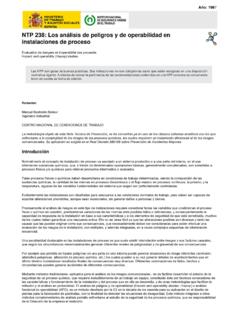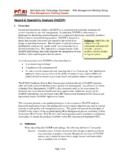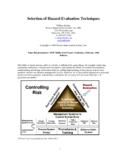Transcription of HSL/2005/58 REVIEW OF HAZARD …
1 HEALTH AND SAFETY LABORATORY An agency of the Health and Safety Executive Crown copyright (2000) Broad Lane, Sheffield, S3 7HQ Telephone: +44 (0)114 289 2000 Facsimile: +44 (0)114 289 2500 REVIEW OF HAZARD IDENTIFICATION TECHNIQUES HSL/2005/58 Project Leader:John Gould Michael Glossop MEng, PhD Agamemnon Ioannides BEng, MSc John Gould BSc HEALTH AND SAFETY LABORATORY An agency of the Health and Safety Executive Summary Objectives The objective of this project was to gain an overview of the HAZARD identification techniques commonly used at sites that will fall within the COMAH Regulations [COMAH 1999].
2 This has been achieved by:- (i) Performing a comprehensive literature REVIEW of HAZARD identification techniques and summarising in a document. (ii) Reviewing the relative strengths and shortcomings of current HAZARD identification techniques with a view to providing advice to CHID and identifying where further advice is required. Main Findings This report has provided a useful overview of the majority of the HAZARD identification techniques that will be found in COMAH reports and other high HAZARD industries. It has also given an indication of the applicability of each technique for SME s, offshore and nuclear facilities. There are a wide range of HAZARD identification techniques available most of which have many examples published. In total, 40 techniques have been identified in this study.
3 However with the notable exception of HAZOP there are few formal guidance documents on the application of such techniques. The most common method of learning to apply a technique is attendance at one of the many training courses or working with a more experienced colleague. The lack of formal guidance is to be expected with a range of techniques that need to be very flexible to allow application to a wide range of circumstances without discouraging free thinking. The guidance available appears to concentrate on providing a description of the technique rather than setting any standards relating to the quality of its application. HEALTH AND SAFETY LABORATORY An agency of the Health and Safety Executive Main Recommendations (i) Feedback on this work should be sought from both industry and the regulators of experience gained from applying HAZARD analysis to satisfy the COMAH Regulations.
4 This report should be updated to take into account any significant comments. (ii) A small number of techniques that are most commonly used on COMAH installations should be reviewed in greater detail. This detailed REVIEW should provide guidance on the information required for COMAH reports and assessment criteria. HEALTH AND SAFETY LABORATORY An agency of the Health and Safety Executive Contents 1 INTRODUCTION 1 Aim 1 2 BACKGROUND 1 3 METHODOLOGY 2 4 LITERATURE REVIEW 3 5 APPLICABILITY OF TECHNIQUES TO DIFFERENT PHASES OF A PROJECT 4 6 REVIEW OF TECHNIQUES 6 Process hazards identification 6 HAZOP 7 What if? analysis 8 Concept HAZARD Analysis (CHA) 9 Concept Safety REVIEW 10 Preliminary HAZARD Analysis (PHA) 10 Fault Tree Analysis (FTA) 12 Cause-Consequence Analysis (CCA) 13 Pre-HAZOP 14 Standards/Codes of practice/Literature REVIEW 15 Functional Integrated HAZARD Identification (FIHI) 16 Checklists 17 Critical Examination of System Safety (CEX) 18 Method Organised Systematic Analysis of Risk (MOSAR) 18 Goal Oriented Failure Analysis (GOFA) 19 Matrices 20 Inherent HAZARD Analysis 21 Hardware hazards identification 22 Safety audit 22 Failure Mode and Effect Analysis (FMEA) 24 Functional FMEA 25 Failure Modes, Effects, and Criticality Analysis (FMECA)
5 25 HEALTH AND SAFETY LABORATORY An agency of the Health and Safety Executive Maintenance and Operability study (MOp) 26 Maintenance Analysis 27 Sneak Analysis 28 Reliability Block Diagram 29 Structural Reliability Analysis 30 Vulnerability Assessment 31 DEFI method 31 Control hazards identification 32 Computer HAZOP (CHAZOP) 32 Structured methods 33 Structured english 33 Specification language 34 Structured Analysis and Design Techniques (SADT) 35 State-transition Diagrams 36 Petri-nets 36 GRAFCET 36 Human hazards identification 37 Task Analysis 37 Hierarchical Task Analysis (HTA) 39 Action Error Analysis (AEA) 39 Human Reliability Analysis 40 Pattern search method 41 Predictive Human Error Analysis (PHEA) 41 7 COMPARISON OF TECHNIQUES 42 8 DISCUSSION 45 9 CONCLUSIONS 45 10 RECOMMENDATIONS 45 11 REFERENCES 46 HEALTH AND SAFETY LABORATORY An agency of the Health and Safety Executive 1 1 INTRODUCTION The chemical and process industries have been using a variety of HAZARD identification techniques for many years, the most well known of which is HAZOP.
6 Each technique has its own strengths and weaknesses for identifying hard ( mechanical) and soft ( computer controls) failures. Establishments that will be top tier sites under the forthcoming COMAH Regulations [COMAH 1999] are required to demonstrate that they have identified all the major hazards of their facilities and Inspectors will be expected to have some expertise in evaluating these techniques and identifying weaknesses. There has been little investigation into the effectiveness and evaluation of these different HAZARD identification techniques and guidance is required for both Inspectors and SME s. Aim The objective of this project is to gain an overview of the HAZARD identification techniques used at sites that will fall within the COMAH Regulations.
7 This will be achieved by:- (i) Performing a comprehensive literature REVIEW of HAZARD identification techniques and summarising them in a document. (ii) Reviewing the relative strengths and shortcomings of current HAZARD identification techniques with a view to providing advice to CHID, and identifying where further advice is required. This report examines various aspects of the HAZARD analysis. It covers the importance of choosing an appropriate HAZARD identification technique (section 2), how the REVIEW of the techniques was performed (section 3), details of the literature REVIEW (section 4), the phases of the process life cycle (section 5), summarises the HAZARD identification techniques (section 6), makes a comparison of the applicability of each techniques for various types of installation (section 7).
8 The information provided in the report was then discussed (section 8), and a number of conclusions (section 9) and recommendations (section 10) were made. 2 BACKGROUND HAZARD analysis involves the identification of hazards at a facility and evaluating possible scenarios leading to unwanted consequences. The HAZARD analysis stage is a very important part of the risk management process, as no action can be made to avoid, or reduce, the effects of unidentified hazards . The HAZARD analysis stage also has the largest potential for error with little or no feedback of those errors. HAZARD analysis relies on a structured and systematic approach to identify potential hazards . There are a large number of techniques that can be used to perform this task at various stages during the life cycle of the process.
9 These vary from a concept safety REVIEW , which is performed as early as possible in the concept stage of the process, to a HAZOP study which can be performed on a fully operational plant. As well as being performed at different stages during the life cycle of the process, the level of detail for the different techniques is significant. Concept safety REVIEW can only be used to provide insight in to the potential major hazards of the process, and hence steer the design of the plant to be more inherently safe. In contrast a HAZOP study is a systematic REVIEW of the process and should be able to identify the causes and consequences of deviations from the design intent. HEALTH AND SAFETY LABORATORY An agency of the Health and Safety Executive 2 It is important to choose the most appropriate identification technique, as this not only provides the appropriate level of detail, but can also be aimed at identifying hazards relating to specific areas.
10 There are many factors to consider when choosing a technique. Many techniques have similar objectives and applied correctly should give comparable results. The HAZARD identification techniques are structured processes to identifying fault conditions that lead to hazards , and reduce the chance of missing hazardous events. They all require considerable experience and expertise. 3 METHODOLOGY This REVIEW of the HAZARD identification techniques commonly used at major HAZARD sites is a desk top study with most of the information extracted from references after a literature REVIEW . There are already several references available that list HAZARD identification techniques [CCPS 1992, Eades 1998, Greenberg 1992, Lees 1980, Parry 1986, Stewart 1997, Wells 1996, Worsell 1994], however none of these are comprehensive, and many only provide a brief listing of methodologies.
















